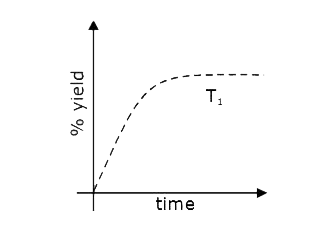Te yield of product in the reaction
A2(g)+B2(g)⇔2AB(g),ΔH=+ve
Unaffected by pressure
It occurs at 1000 pressure
It occurs at high temperature
It occurs at high pressure and high temperature
The correct Answer is:A
Reaction will be unaffected by pressure because Δn=0
Topper's Solved these Questions
- CHEMICAL EQUILIBRIUMBOOK - ERRORLESSCHAPTER - CHEMICAL EQUILIBRIUMEXERCISE - PAST YEARS QUESTIONS
37 Videos
- CHEMICAL EQUILIBRIUMBOOK - ERRORLESSCHAPTER - CHEMICAL EQUILIBRIUMEXERCISE - ASSERTION & REASON
12 Videos
- CHEMICAL EQUILIBRIUMBOOK - ERRORLESSCHAPTER - CHEMICAL EQUILIBRIUMEXERCISE - NCERT BASED QUESTION (Activation Energy, Standard Free Energy and Degree of Dissociation and Vapour Density)
17 Videos
- CHEMICAL BONDING AND MOLECULAR STRUCTUREBOOK - ERRORLESSCHAPTER - CHEMICAL BONDING AND MOLECULAR STRUCTUREEXERCISE - Assertion & Reason
17 Videos
- CLASSFICATION OF ELEMENTS AND PERIODICITY IN PROPERTIES BOOK - ERRORLESSCHAPTER - CLASSFICATION OF ELEMENTS AND PERIODICITY IN PROPERTIES EXERCISE - Assertion & Reason
14 Videos
Similar Questions
Using Le-Chatelier's principle, predict which conditions of temperature and pressure would give high yield of products in the following reactions:
(i) CO2(g)+H2(g)⇔H2O(g)+CO(g) ;ΔH=+41kJ
(ii) 2SO2(g)+O2(g)⇔2SO3(g) ;ΔH=−198kJ
(iii) N2(g)+O2(g)⇔2NO(g) ;ΔH=175kJ
View SolutionThe yield of product in the reaction,
A2(g)+2B(g)⇔C(g)+QKJ
would be higher at:
View Solution
Knowledge Check
Which one of the following condition will favour maximum formation of the product in the reaction. A2(g)+B2(g)⇔X2(g)ΔrH=−X kJ ?
ALow temperature and high pressureBLow temperature and low pressureCHigh temperature and high pressureDHigh temperature and low pressureFor the reaction A(g)⇔B(g)+C(g)
AKp=α3PBKp=α2(Kp+P+1)CKp=α2(Kp+P)DKp=α2(KP+PP)For the reaction
N2(g)+3H2(g)⇔2NH3(g),ΔH=?AΔE+2RTBΔE−2RTCΔE+RTDΔE−RT
The % yield of ammonia as a function of time in the reaction N2(g)+3H2(g)⇔2NH3(g),(g)ΔH<0 at (P,T1) is given below

View SolutionWhich of the following factors will be favourbale for higher yields of NO in the reaction given below ?
N2+O2⇔2NO(g)(ΔH=+ve)
View SolutionThe following two reaction are known :-
N2(g)+O2(g)⇔2NO(g),ΔH=−27.1KJ
2N2(g)+O2(g)⇔2NO2(g),ΔH=−53.5KJ
Calculate the enthalpy change for the reaction
NO2(g)⇔12N2(g)+O2(g)
View Solution(,List-I,,List-II),((P),Kp=20atm−1,(1),No effect of pressure on the yield of the product),((Q),H2(g)+I2(g)⇔2HI(g),(2),ΔH=ΔE−RT),((R),N2+3H2⇔2NH3,ΔH=−ve,(3),Non-spontaneous process),((S),ΔGpT>0,(4),kpdecreases with temperature)
View Solution(,List-I,,List-II),((P),Kp=20atm−1,(1),No effect of pressure on the yield of the product),((Q),H2(g)+I2(g)⇔2HI(g),(2),ΔH=ΔE−RT),((R),N2+3H2⇔2NH3,ΔH=−ve,(3),Non-spontaneous process),((S),ΔGpT>0,(4),kpdecreases with temperature)
View Solution
